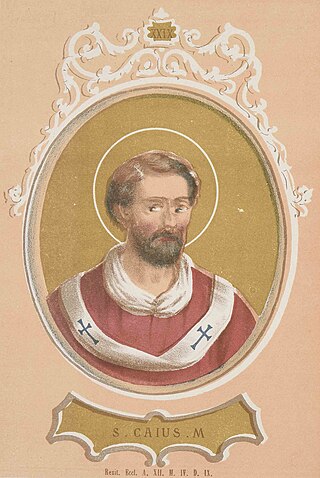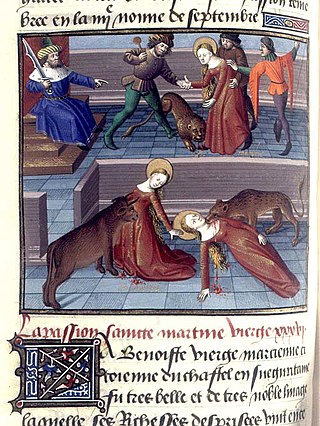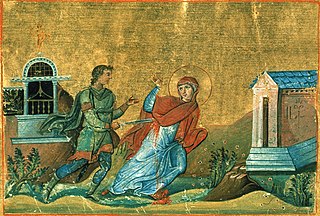Related Research Articles

Pope Miltiades, also known as Melchiades the African, was the bishop of Rome from 311 to his death on 10 or 11 January 314. It was during his pontificate that Emperor Constantine the Great issued the Edict of Milan (313), giving Christianity legal status within the Roman Empire. The pope also received the palace of Empress Fausta where the Lateran Palace, the papal seat and residence of the papal administration, would be built. At the Lateran Council, during the schism with the Church of Carthage, Miltiades condemned the rebaptism of apostatised bishops and priests, a teaching of Donatus Magnus.

Pope Caius, also called Gaius, was the bishop of Rome from 17 December 283 to his death in 296. Little information on Caius is available except that given by the Liber Pontificalis, which relies on a legendary account of the martyrdom of Susanna of Rome for its information. According to legend, Caius baptized the men and women who had been converted by Tiburtius and Castulus. His legend states that Caius took refuge in the catacombs of Rome and died a martyr.
Cyriacus, sometimes Anglicized as Cyriac, according to Christian tradition, is a Christian martyr who was killed in the Diocletianic Persecution. He is one of twenty-seven saints, most of them martyrs, who bear this name, of whom only seven are honoured by a specific mention of their names in the Roman Martyrology.

Gorgonius or Gorgon was a Christian who was martyred in AD 304 alongside Peter Cubicularius and a certain Dorotheus at Nicomedia during the Diocletianic Persecution.

The deacon Apollonius and his convert Philemon were Christian martyrs of the Diocletianic Persecution around 303. Philemon was a famous flute player, mime and actor at Antinoöpolis in Egypt.

Saints Cyprian and Justina are honored in the Catholic Church, Eastern Orthodox Church and Oriental Orthodoxy as Christians of Antioch, who in 304, during the Diocletianic Persecution, suffered martyrdom at Nicomedia on September 26. According to Roman Catholic sources, no Bishop of Antioch bore the name of Cyprian.

Sabinus of Spoleto was a bishop in the early Christian church who resisted the Diocletianic Persecution and was martyred.
Elias and four companions, Daniel, Isaiah, Jeremiah, and Samuel were Egyptian martyrs. Their feast day is February 16.

Alexander of Bergamo is the patron saint of Bergamo, as well as Capriate San Gervasio and Cervignano d'Adda. Alexander may have been a Roman soldier or resident of Bergamo who was tortured and killed for not renouncing his Christian faith. Details of his life are uncertain, but subsequent Christian stories consider him a centurion of the Theban Legion commanded by Maurice.

Saint Colluthus is a Coptic saint and martyr of the 3rd century AD said to be from Antinoöpolis.

Psote, also known as Bisada, Besada, Psate/Psati, Abashadi, Abassadius, or Beshada, was a bishop of Ebsay in Upper Egypt. He was martyred by beheading at Antinoe. St. Apa Psote was a revered Coptic Orthodox bishop from the city of Psoi, known for his devout faith and martyrdom during the Diocletianic Persecution, a time of severe repression against Christians in the Roman Empire.

Saints Marcellinus and Peter are venerated within the Catholic Church as martyrs who were beheaded. Hagiographies place them in 4th century Rome. They are generally represented as men in middle age, with tonsures and palms of martyrdom; sometimes they hold a crown each.
Abibus of Samosata was a Christian martyr at Samosata. He lived during the period of Diocletianic Persecution. He was arrested for refusing to take part in a pagan ritual to celebrate the victory of Emperor Maximian over the Persians. He was thrown to prison where his body was scratched with iron, he had heavy shackles over his neck. In 297 he was sentenced to be executed by crucifixion. After having lived for two days on the cross, he was taken down and his head was pierced by nails. He was crucified together with other martyrs – James, Romanus, Lollius, Philotheus and Paregrus. All these martyrs were commemorated on 29 January in the Byzantine Church and by the Armenian Church in October.

Marciana of Toledo, also known as Marciana of Mauretania and Marciana of Caesarea, is venerated as a martyr and saint.

Saint Anysia of Thessalonica was a Christian virgin and martyr of the 4th century. She was born of pious and affluent parents who "raised her in Christian piety". They died when Anysia was young, leaving her their wealth, which she distributed to the poor, choosing to live "a strict life of fasting, vigil, and prayer".
Anthony was an early Christian priest who suffered martyrdom with Anastasius, Julian, Celsus and Marcionilla during the Diocletianic Persecution. Denouncing the Roman way of life, he lived as a desert hermit, practiced celibacy, lived off roots and plants, and shunned any visitors he received. Anthony wished to live his life in complete solidarity with God.

Saint Peleus was an early Christian martyr. An Egyptian bishop, Peleus was one of four Christians who led Mass for the persecuted Christians condemned to work in the Palestinian quarries in the wake of the Diocletianic Persecution. When the Roman emperor Galerius learned of this, he had Peleus burned alive along with the other leaders, and the Christians dispersed to mines in Cyprus and Lebanon. He is venerated as a saint in the Roman Catholic Church, Eastern Orthodox Church and Coptic Orthodox Church.
Nilus of Palestine was an early Christian martyr. An Egyptian bishop, Nilus was one of four Christians who led Mass for the persecuted Christians condemned to work in the Palestinian quarries in the wake of the Diocletianic Persecution. When the Roman emperor Galerius learned of this, he had Nilus burned alive along with the other leaders, and the Christians dispersed to mines in Cyprus and Lebanon. He is venerated as a saint in the Roman Catholic Church, Eastern Orthodox Church and Oriental Orthodox Church.
Patermutius was an early Christian martyr. A layman, Patermutius was one of four Christians who led Mass for the persecuted Christians condemned to work in the Palestinian quarries in the wake of the Diocletianic Persecution. When the Roman emperor Galerius learned of this, he had Patermutius burned alive along with the other leaders, and the Christians dispersed to mines in Cyprus and Lebanon. He is venerated as a saint in the Roman Catholic Church and Eastern Orthodox Church.
Pelagia the Virgin, also known as Pelagia of Antioch, was a Christian saint and virgin martyr who leapt to her death during the Diocletianic Persecution in refusal to offer a public sacrifice to the pagan gods by Roman soldiers, or to do "something unspeakable ", typically inferred as the Roman soldiers attempting to rape her. She is venerated as a saint in the Eastern Orthodox Church and Roman Catholic Church.
References
- ↑ Butler, Alban (December 1, 1956). Butler's Lives of the Saints (New Full ed.). St John's Abbey, Collegeville, Minnesota: Christian Classics. p. 181. ISBN 0-8146-2385-9.